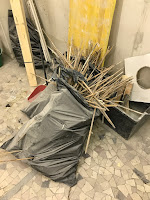SPAZIO
The circles of Hell
Men leave no stone unturned when in pursuit of "progress". The consequences rarely matter, even if well documented. In Behemoth (2015), Zhao Liang masterly depicts the working conditions in a coal mine in Inner Mongolia and the destruction of a land that used to be inhabited mainly by nomadic herders. Explosives uncover precious rocks while hundreds of trucks build up new Death Valleys. The hellish noise of the factories plays against the rattle of the many workers dying of occupational lung disease.
Q: Where will we go when no trace of grace is left in the world?
A: What about ghost towns?
Love your neighbour
In 1952, Canadian film-maker Norman McLauren wrote and directed Neighbours. The documentary was produced by the National Film Board of Canada (NFB) and it lasts just eight minutes and six seconds. It won an Oscar and in 2009 was added to UNESCO's Memory of the World Programme, an international initiative launched in 1992 to safeguard the documentary heritage of humanity against collective amnesia, neglect and deliberate destruction.
Norman McLauren, Neighbours, NFB, 1952.
Into the real world
Dear friends and colleagues,
Spazio is getting ready to venture into the real world and start addressing spatially some of the topics discussed here. It is still very much a work in progress but I will soon disclose all the details.
Spazio, new gallery, photographs Mariana Siracusa
Wonderland Vrin
In 1998, the Swiss Heritage Society awarded the village the Wakke Prize for the masterful integration of modern agricultural buildings into its historic fabric. The terrific work by Gion Caminada is well known to architects.
"Vrin. A Village in the Alps." Filmmaker, Marc Schwarz
What impressed me the most when walking around on a cold Sunday morning was the spatial quality that results from carefully siting one building close to the other. The space between has a perfect human scale. Maybe because it was cold and snowing it reminded me of the way animals stand close to each other to stay warm during the winter.
Gion Caminada, House Caminada, 2000
In the 1980s, the municipality purchased all the available building land in other to prevent speculation. It was partly used to build communal offices, a multipurpose hall, a butcher's shop, a telephone booth, agricultural buildings, and a mortuary.
Gion Caminada, Stiva da morts, Community Mortuary Building, 2002
Gion Caminada, Stiva da morts, Community Mortuary Building, 2002
Gion Caminada, Bus Stop, 2015
It is surprising how even the smallest buildings (bus stop and telephone booth) have been perfectly detailed to shelter from and react to snow and wind. During the summer these same buildings will probably reveal a different face.
Photographs, Mariana Siracusa
Further reading
Bettina Schlorhaufer, ed. Cul zuffel e l'aura dado. Gion A. Caminada. Luzern: Quart Verlag, 2008.
A few more books before the end of the year
Silke Langenberg. Das Marburger Bausystem. Open as a matter of principle. Sulgen: Niggli Verlag, 2013.
It is always such a pleasure to open a Niggli book. The layout is impeccable, the photographs are well printed. They get right the weight, the format, the paper, the font, everything. Their books even smell good. The object is as important as the content. Chapeau!
Felicity Scott's latest book is all about the content. I especially enjoyed the chapter about Kevin Roche and the Ford Foundation Headquarters which sets the tone for the whole book.
Felicity D. Scott. Outlaw Territories. Environments of Insecurity / Architectures of Counterinsurgency. New York: Zone Books, 2016.
Also fascinating is the topic chosen by Clare Lyster: logistics. In the book she reads urban spaces according to operation systems and procedurals flows. Ryanair route network, FedEx network operations, Amazon storage spaces... and movement: movement is the key.
Clare Lyster. Learning from Logistics. How Networks Change Our Cities. Basel: Birkhäuser, 2016.
With The Space Between the trilogy that Alison and Peter Smithson started when they published The Charged Void (check out their 1976 lecture) is completed.
I believe the books on Herzog and de Meuron do not need any explanation.
Jean-François Chevrier. From Basel. Herzog & de Meuron. Basel: Birkhäuser, 2016.
The photographs of Richard and Cherry Kearton taking photographs in the landscape are quite unique and allow the reader to understand the labor behind their images.
John Bevis. The Keartons. Inventing Nature Photography. Axminster, Devon: Uniformbooks, 2016.
Content-wise I would certainly recommend The Apparent Marginal Activities of Marcel Duchamp. The author makes such an excellent point on the artist that makes you wonder why nobody thought about it before. If you are interested in curatorial practices you will be compelled to read it cover to cover. Together with Appearance Stripped Bare by Octavio Paz, this is the best book on Duchamp that I have read.
Elena Filipovic. The Apparently Marginal Activities of Marcel Duchamp. Cambridge, MA: MIT Press, 2016.
Subscribe to:
Comments (Atom)




















































